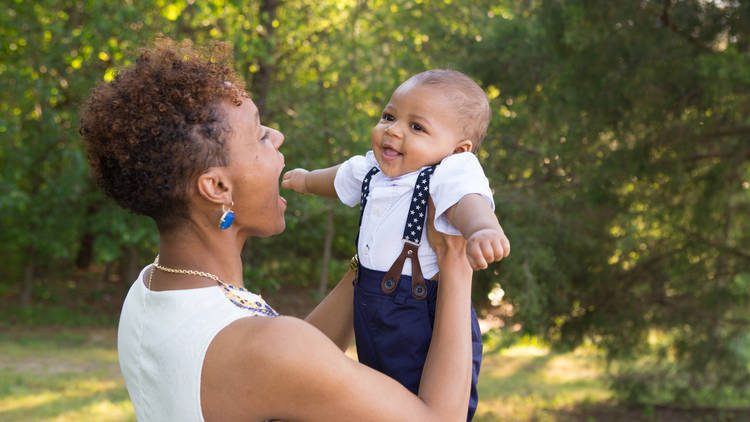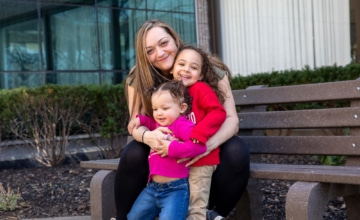You’ve survived the first 3 months, giving everything you’ve got to help your baby adjust to her new world. Browse the information and links below to see what your little one is experiencing and learning this month.
What It’s Like for You
Your hard work has paid off. You know her so much better than you did on day one. You know what many of her signals mean—her ways of letting you know she is tired, hungry, or has a dirty diaper. You know the special voice that she finds comforting, how to rub her back when she needs to burp, and how to make her laugh. Some of these signals may be unique to your child.
Carrie-Lynn, mother of Krystal (4 months), explains: On her first day at child care, Krystal’s caregiver called me to say that she might have an ear infection. I asked her why she thought that and she told me it was because Krystal keeps pulling on her ear lobes. I started laughing and told her that Krystal pulls on her ears when she’s tired, and that if she put her down for a nap, Krystal would be just fine. So she did, and when Krystal woke up—no more pulling on her ears. As weird as it sounds, the whole thing made me feel good in a way, that even though Krystal was in child care, I still knew her best.
Now that your baby is awake and alert much more during the day, she’s more eager than ever to connect and interact with you. The two of you can play back-and-forth games, like shaking rattles and having funny gurgly “chats” as she starts to use her sounds more and more to communicate. This is when the fun part really starts!
What It’s Like for Baby
I love my rattle! Daddy says, Let’s watch it fly! and he moves it through the air for me to see. My arms and legs go like egg-beaters! Then Daddy dips it down and makes it touch my nose. We both laugh. When Daddy hands the toy to me, I put it in my mouth right away to find out: How does it feel, how does it taste, what does it do? Then I decide to shake the rattle and—oh, Wow!—it makes the greatest tinkly noise ever! Dad claps his hands and smiles at me. I feel pretty smart. Then Daddy starts playing my favorite game of all. He starts quietly, saying, Achoo. He keeps making that funny sound over and over again, very quiet. Then he gives me a big smile. I know what comes next! I open my eyes wide and kick my legs out straight. He takes a deep breath and says ACHOO super loud. I start giggling so hard, and so does he. It’s really fun to play with Daddy!
What Your Baby Is Learning
Language and Communication:
- The sound of words and rhythm of language as his dad talks with him.
- The “rules” of communication as he and his dad take turns talking (or cooing) with each other.
Social-Emotional Skills:
- Confidence and a sense of being loved and appreciated when his dad shows him how much fun he is to be around.
- Positive self-esteem as this baby realizes that he can make people react and respond to him.
Thinking Skills:
- Cause and effect when he shakes the rattle and it makes a noise.
- Information about the textures and shapes (such as edges and corners) as he explores the rattle with his eyes, hands, and mouth.
- Patterns, like the pattern of the quiet Achoo versus the loud ACHOO.
Physical Skills:
- Hand-eye coordination when he reaches for and grasps the rattle.
What to Expect From Your Baby’s Development
As you review the chart, keep in mind that development is not a race and that every child grows at her own pace and in her own way. Your child may develop skills faster or slower than indicated below and still be on track. If you have questions or concerns, talk with your child’s health care provider or other trusted professional.
Your Toddler’s Development From 3 to 6 Months
| What Your Baby Can Do | What You Can Do to Connect With Your Baby |
|---|---|
I am learning to control my body. |
|
|
|
I use my hands and fingers to explore. |
|
|
|
I communicate by using sounds, actions, and facial expressions. |
|
|
|
I am ready for books. |
|
|
|
I am getting used to the world around me. |
|
|
|
Did You Know…
That the way you respond at the doctor’s office when your baby is getting a vaccination affects how she reacts to it? Researchers found that 4- and 6-month-old babies whose parents sang, joked, and talked with them during vaccinations cried the least and showed less intense pain expressions than babies whose parents did none of the above. Interestingly, babies’ distress seemed to increase when parents apologized for the immunization or tried to reassure their little ones.
What the Research Means for You
Even at just 4 months, your baby is responding to your facial expressions, tone of voice, and other “signals” you’re sending. When you act worried, your baby may sense this and become stressed too. When you are calm, your baby is more likely to be calm. You can help your baby get through necessary vaccinations by joking around, singing his favorite silly songs, and chatting about something other than the procedure. Don’t apologize or show fear or worry—this gives the message that something bad has happened, or is about to happen. Instead, stay calm and upbeat and your child will likely recover more quickly from the momentary discomfort of the shot.
Spotlight on: Sounds and Language
Your baby has been making little coos and gurgles for a while now. These sounds are a key step toward speaking words. Babies learn how to make these sounds through imitation—they copy the sounds they hear you use. That’s why it’s so important to talk to babies from birth, because it’s how they learn to speak. Research shows that the more a parent talks to her child, the larger the child’s vocabulary.
Your baby’s language skills will usually begin with cooing (gurgly ooo and aaah sounds). Then your baby will start to babble, stringing lots of these little sounds together to “tell” you something important. While most babies don’t say their first words until about 9-12 months, they are already telling you what they think, want, and need by using their facial expressions (smiles, frowns), sounds (like crying and cooing), and body movements (like kicking, reaching, stretching, and arching her back). These signals are unique to each baby. Your baby will develop her own ways of telling you what she needs.
Responding to your baby’s communications is important for many reasons. It makes her feel important and loved. It teaches her how to communicate back and forth with others. She learns new words. And, she learns that she is a good communicator. Sometimes you guess right about the message you think she sent—you gave her milk when you saw her sucking on her fingers and boy, was she happy! And sometimes you don’t guess right. You hand her the ball when what she really wants is the rattle. What’s important is that you keep trying. If you thought she was hungry but she turns away from the breast or bottle, try something else. Maybe she wants to be held in a different way or just wants to suck on a pacifier. By listening and watching carefully, and experimenting with different responses, you can learn to “speak” your baby’s language, just like she spends her first few years learning to speak yours.
What you can do to support early language development:
- Describe your baby’s feelings and experiences. For example, when you see that she is hungry, you can say: You are nuzzling at my shirt. You’re telling me you’re hungry. Okay, your milk is coming right up! Although your baby won’t understand your words right away, your caring, loving tone of voice and actions will make her feel understood and lets her know that her needs will be met. And hearing these words over and over again will help her understand their meaning over time.
- Copy your baby’s sounds and actions. And encourage him to imitate you.
- Notice and talk about what engages her. You are watching that doggy over there. He is so big and furry. Hi, doggy!
- Respond to your baby’s efforts to communicate. When he fusses as you change his diaper, you might tell him: These diaper wipes are cold and yucky, aren’t they? I know you don’t like this part very much. Don’t worry, we are almost done!
- Sing songs you know, or make up songs about your baby. Happy bath-time to you, happy bath-time to you, happy bath-time, sweet baby, happy bath-time to you. Don’t worry—this is not American Idol! Your baby doesn’t care if you are on key or good at carrying a tune. Babies just love hearing your voice.
- Read to your baby. Books with simple, large pictures or designs with bright colors are especially interesting to young babies.
- Don’t take crying or fussing personally. If you try soothing your baby and he keeps crying, it’s not because you’re doing something wrong. Maybe he needs to be held a different way, or rocked, or he is just cranky today. Experiment with different responses to see what works for him.
Let’s Play: Activities That Nurture Bonding and Learning
Beach Ball Time
Place your baby tummy side down on a slightly deflated beach ball. Turn his head to one side. Then, while securely holding him, rock him slowly forward and back or side to side on the ball. Sing or talk to him while you play. Games like this help babies develop neck, shoulder, and trunk strength. (This gentle rhythm and pressure can also be soothing if he is having tummy troubles.)
Roll With It
Lay your baby on her back and hold an interesting toy (a rattle or baby-safe mirror) in front of her. Let her reach for it and grasp it. Then hold it in front of her again and, as she reaches, slowly move it to one side so that she is reaching across her body. Give her lots of encouragement for working so hard. Eventually your baby will be able to roll over in order to reach the toy.
What’s on Your Mind?
1. My 4-month-old isn’t rolling over yet. While my doctor said this is not uncommon, all the other babies in my mom’s group are rolling. What can I do to help him catch-up?
There’s no need for your baby to catch up, because he’s not behind. Development is not a race. Babies develop at their own pace and in their own way. While development does tend to progress in a particular order—most children crawl before they walk, for example—children achieve these milestones within a relatively wide time range. Rolling is no exception.
If your doctor has assessed your son’s physical and motor skills and has found that he is progressing well, he will roll when he is ready. Children are driven to learn, grow, and develop new skills. They don’t need to be pushed to take the next step. What you can do is give your son lots of time each day to play on both his belly and his back. As babies play, they are also learning how to move their bodies in order to see and do more. Babies who are held most of the day or who spend lots of time in infant seats or carriers miss this opportunity to develop the muscle strength and coordination they need to learn to roll. Most importantly, delight in who your son is right now. There is no need to rush. He’ll be moving before you know it.
2. My 4-month-old has all these toys my parents and other relatives have given her but she doesn’t seem interested in playing with them. When will she be?
Though children’s interests and skills vary, your daughter should have some curiosity about toys now, as long as they’re age-appropriate. Most 4-month-olds are able to reach out and explore toys with their hands, and are beginning to grasp and shake or bang them. The best toys at this age are those that your daughter can easily reach and hold like rattles with handles, soft rubber rings, and toys that she can squeeze, touch, and kick. Since her toys are probably going to be sucked and gummed a lot (that’s one of the main ways babies play at this age), it’s essential that all of these objects are safe for her to put in her mouth.
Babies this age aren’t yet able to operate toys in complicated ways, such as pressing a button on a pop-up toy. If these are the kinds of “big kid” toys that your daughter has been given, her lack of interest is understandable. She can’t easily grasp and chew on them, which is what she’s interested in right now. Instead, offer your baby a range of toys that are appropriate for her age and see how she responds. Just like most parenting challenges, choosing toys is all about trial and error. Some things you get will be a hit, while others will gather dust. (Look into starting a toy-sharing group with other moms of similarly-aged babies to make the most of your purchases.) You’ll see your daughter’s fascination with toys and other objects grow in the coming months as her hand and vision skills continue to develop.
What’s important is that your child is showing interest in objects and people. She should be exploring the world around her by looking, by touching, and by using her mouth. She should also be using her body to communicate, such as kicking her arms and legs in delight and vocalizing back and forth with you. If you are seeing this kind of behavior and communication, then she is doing just fine.
3. Our 4-month-old loves to be tossed up and down, but my mother says this is dangerous. Is she right?
Your mother’s concern likely stems from the highly-publicized and very serious problem called “shaken baby syndrome.” Shaken baby syndrome results from violently shaking a baby (usually under 6 months) while holding the infant by the trunk or by the shoulders. Forceful shaking causes tearing of the small blood vessels on the surface of the brain that can interrupt blood flow and can lead to brain damage.
The experience of being tossed up into the air no more than a foot or so is unlikely to harm your baby. This action does not generate enough force to cause your baby harm.
However, as much as your baby enjoys being tossed into the air, there is always the chance that the person tossing her will drop her accidentally and cause physical harm. While this risk is admittedly very small, play it safe and choose other ways to be active together. Try dancing, swaying, swinging, and other movement activities that offer little or no chance of injury.
Expert Reviewers
- Terrie Rose, PhD, President and Founder, Baby’s Space
- Ross Thompson, PhD, Professor of Psychology, University of California at Davis
- Robert Weigand, MS, IMH-E, Director, Child Development Laboratory, Arizona State University
*Additional reporting by Claire Lerner





